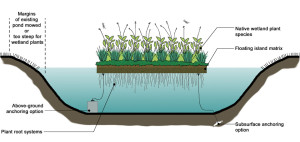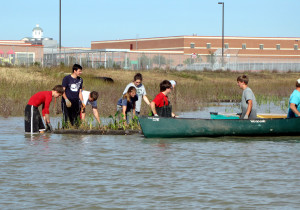
A floating wetland island demonstration project in the Baltimore Harbor. Source: Healthy Harbor Baltimore
TCWP is demonstrating a way to bring the water-cleansing qualities of a natural wetland to stormwater detention basins where the water level is too deep and fluctuating, or the shores are too steep for a typical in-ground wetland. A floating wetland island is a man-made raft that floats on the water’s surface and houses native wetland plants. These floating wetlands have plant, soil and root interactions similar to a natural wetland and provide homes to beneficial water-cleaning microorganisms. Floating wetland islands are anchored to stay in one area of the pond but can rise and fall as the water level in the basin changes 1. These islands can be installed in an existing wet basin without re-grading the side slopes or other costly retrofits.
Research in other states shows that floating wetland islands can reduce nitrogen and phosphorous levels in ponds. One study found 32% removal of phosphorous and 45% reduction in nitrogen in lake water used in a mesocosm (controlled natural setting) experiment 2.
The material of the islands is a dense mesh of polyethylene terephthalate (PET) fibers which have been recycled from plastic waste such as soda bottles. It is an inert material but provides the substrate for biofilms, populations of microbes which directly influence water quality.
Our first installation of floating wetlands is in the six acre stormwater detention basin on campus at Clear Creek Independent School District’s Education Village in League City. TCWP and the school community launched three islands totaling 240 sf in November 2013. The project demonstrates the floating wetland technique for the Galveston Bay Area and is the first public installation in our state. It also complements the schools’ interest in developing the detention pond as an outdoor classroom, and will play a role in a developing curriculum which will include birding, botany, water cycle and watershed studies.
TCWP would like to investigate the use of floating wetland islands at additional sites where changes in water quality can be closely monitored.
1. Tanner, C. and R. Headley. “Components of floating emergent macrophyte treatment wetlands influencing removal of stormwater pollutants” Ecological Engineering. 37(2011)474-486.
2. Tanner, C., J. Sukias, J. Park, C. Yates and T. Headley. “Floating Treatment Wetlands: A new tool for nutrient management in lakes and waterways” http://ebookbrowse.com/floating-treatment-wetlands-a-new-tool-for-nutrient-management-in-lakes-and-waterways-pdf-d338964289
 Texas Community Watershed Partners
Texas Community Watershed Partners 

